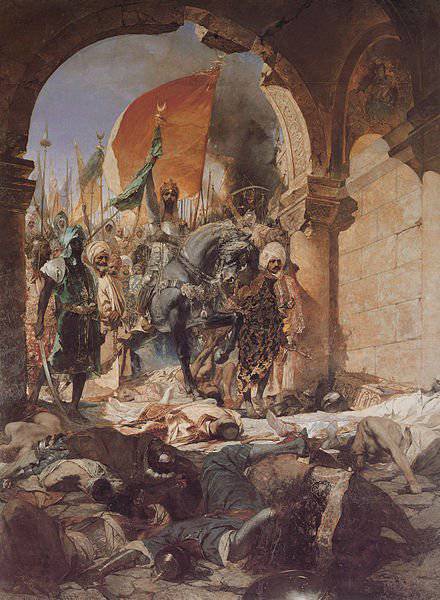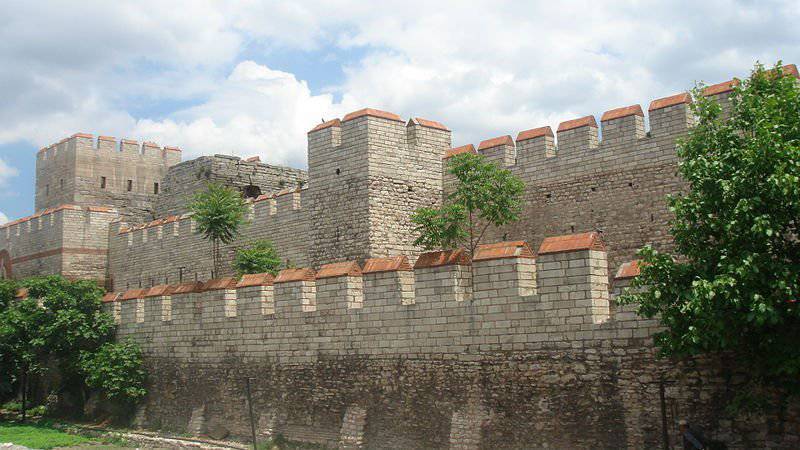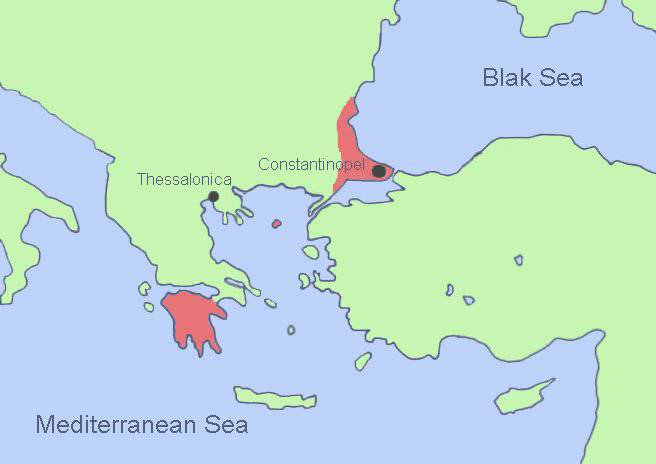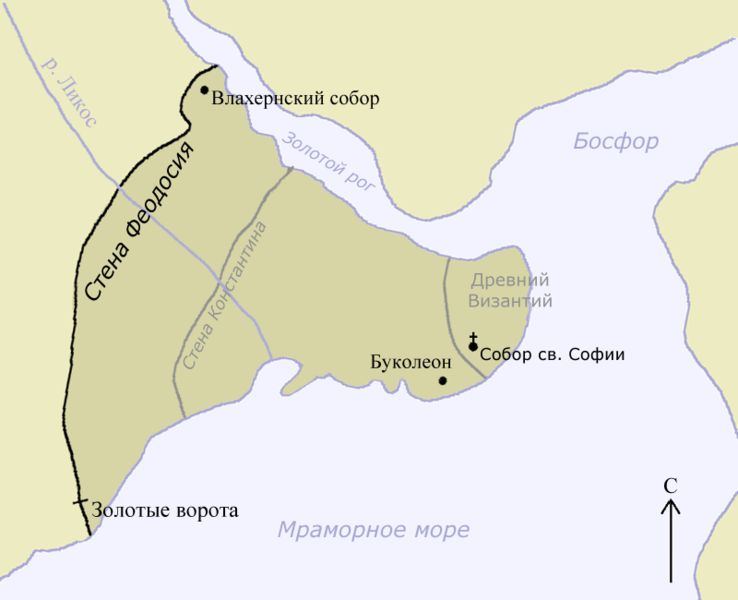Byzantine lessons. To the 560 anniversary of the fall of Constantinople
 29 May 1453, Constantinople fell under the blows of the Turks. The last Byzantine emperor Constantine XI Palaeologus died, fighting heroically in the ranks of the city’s defenders. Constantinople became the capital of the Ottoman Empire, the residence of the Turkish sultans and received a new name - Istanbul. 1100-year period stories Christian Byzantine Empire ended. This victory ensured the Ottomans domination in the Eastern Mediterranean basin, they received full control over the Bosphorus and Dardanelles. Constantinople-Istanbul remained the capital of the Ottoman Empire until its collapse in 1922. Today, Istanbul is the largest city in Turkey.
29 May 1453, Constantinople fell under the blows of the Turks. The last Byzantine emperor Constantine XI Palaeologus died, fighting heroically in the ranks of the city’s defenders. Constantinople became the capital of the Ottoman Empire, the residence of the Turkish sultans and received a new name - Istanbul. 1100-year period stories Christian Byzantine Empire ended. This victory ensured the Ottomans domination in the Eastern Mediterranean basin, they received full control over the Bosphorus and Dardanelles. Constantinople-Istanbul remained the capital of the Ottoman Empire until its collapse in 1922. Today, Istanbul is the largest city in Turkey. It is clear that by the time of the fall Constantinople was already a fragment of the former greatness of the great empire, which owned lands from North Africa and Italy to the Crimea and the Caucasus. The power of the Byzantine emperor extended only to Constantinople with its suburbs and part of the territory of Greece with its islands. The Byzantine state in the 13-15 centuries can be called an empire only conditionally. The last Byzantine rulers were actually vassals of the Ottoman Empire. However, Constantinople was the direct heir of the ancient world, was considered the "Second Rome". It was the capital of the Orthodox world, which opposed both the Islamic world and the Pope. The fall of Byzantium was an important milestone in the history of mankind. Especially the "Byzantine lessons" are important in modern Russia.
Geopolitical situation for the 1453 year. Ottoman conquests
The uniqueness of the position of the Byzantine Empire was that it was constantly subjected to military-political pressure from the West and the East. In this respect, the history of Russia is similar to the history of the “Second Rome”. In the east, Byzantium endured numerous wars with the Arabs and the Seljuk Turks, although it lost most of its possessions. The West also presented a grave danger in the light of Rome’s global political plans and the economic claims of Venice and Genoa. In addition, Byzantium has long pursued an aggressive policy towards the Slavic states in the Balkans. The grueling wars with the Slavs also had a negative effect on the defenses of the empire. The expansion of Byzantium gave way to heavy defeats from the Bulgarians and Serbs.
At the same time, from within, the empire was undermined by the separatism of the governors of the provinces, the elite egoism of the feudal lords, the confrontation of the “pro-Western” wing of the political and spiritual elite with the “patriots”. Supporters of a compromise with the West believed that it was necessary to accept the union with Rome, which would allow them to stand in the fight against the Muslim world. This more than once led to popular uprisings, in which citizens were dissatisfied with the policies of the government that patronized Italian merchants, and the middle and lower clergy, who protested against the policy of rapprochement with Rome. Thus, the empire from century to century opposed the enemies in the West and the East, and at the same time was split from the inside. The history of Byzantium was full of uprisings and civil unrest.
In 1204, the Crusader army captured and plundered Constantinople. The empire collapsed into several states - the Latin Empire and the Achaean principality created in the territories controlled by the crusaders, and the Nicene, Trapezund and Epirus empires - remaining under the control of the Greeks. In 1261, the emperor of the Nicaean empire, Mikhail Paleolog, formed an alliance with Genoa and beat Constantinople. The Byzantine Empire was restored.
The Ottomans. At this point in the east, a new enemy - the Ottoman Turks. In the 13th century, one of the Turkic tribes, the Kaiy, under the command of Ertogrul Bey (1198 — 1281), driven from the nomads in the Turkmen steppes, moved to the West. Ertogrul Bey became a vassal of the Seljuk ruler of the Koni Sultanate of Kay-Kubad I (Aladdin Kaykubad) and assisted him in the struggle against Byzantium. For this, the sultan bestowed Ertogrulu on the land in the Bithynia region between Angora and Bursa (without the cities themselves). Prince Ertogrul's son, Osman (1258-1326), was able to dramatically strengthen his position, as the rich Byzantine empire in the West was exhausted by external wars and internal unrest, and the Muslim rulers in the East were weakened after the invasion of the Mongols. His army was replenished with refugees who fled from the Mongols and mercenaries from all over the Muslim world, who sought out Osman in order to fight against the weakening Christian empire and to use its wealth. The massive influx of Muslim refugees and Turks has led to a change in the demographic balance in the region not in favor of Christians. Thus, the mass migration of Muslims contributed to the fall of Byzantium and subsequently led to the emergence of a strong Muslim element in the Balkans.
In 1299, after the death of Aladdin, Osman took the title "Sultan" and refused to submit to the Koni (Romanian) sultans. By the name of Osman, his subjects began to be called Ottomans (Ottomans) or Ottoman Turks. Osman captured the Byzantine cities of Ephesus and Bursa. Often Byzantine cities themselves surrendered at the mercy of the victors. Muslim warriors did not storm the powerful fortifications, but simply devastated the countryside, blocked all ways of transporting food. Cities were forced to capitulate, as there was no outside help. The Byzantines chose to leave the countryside of Anatolia and direct their efforts towards strengthening fleet. Most of the local population was quickly Islamized.
Bursa fell in 1326 year and was turned into the capital of the Ottomans. From 1326 to 1359 was ruled by Orhan, he added an infantry corps to the strong Ottoman cavalry, and began to create units of the prisoners from captured young men. In the 1331, Nikea fell, it was the capital of the Ottomans in 1331 — 1365. 1337, the Turks seized Nicomedia, it was renamed Izmit. Izmit became the first shipyard and harbor for the nascent Turkish naval forces. In 1338, the Ottoman Turks reached the Bosphorus and soon were able to force it at the invitation of the Greeks themselves, who decided to use them in the civil war (1341 — 1347). Turkish troops acted against the side of the future emperor John VI Kantakouzin against the current emperor John V Palaeologus. In addition, John VI regularly used Ottoman troops as mercenaries in the wars with the Serbs and Bulgarians. As a result, the Greeks themselves allowed the Ottomans to the Balkans, and the Turks were free to explore the local political situation, learn about the roads, water sources, forces and weapons of their opponents. In 1352 — 1354 the Turks captured the Gallipoli peninsula and set about conquests in the Balkan Peninsula. In 1354, Orhan captured Ankara, which was ruled by the Mongol rulers.
Sultan Murad I (1359 — 1389) captured Western Thrace in 1361, occupied Philippopol, and soon Adrianople (the Turks called it Edirne), where it moved its capital in 1365. As a result, Constantinople was isolated from the remaining areas of his, and his capture was only a matter of time. Emperor John V Palaeologus was forced to sign an unequal treaty in which Byzantium renounced possession in Thrace gratuitously, pledged not to help the Serbs and Bulgarians in the struggle against the Ottomans, the Greeks also had to support Murad in the struggle with rivals in Asia Minor. In fact, Byzantium became a vassal of the Ottoman state. In 1371, the Ottoman army defeated the allied army of the Prilepsky kingdom (one of the states created after the collapse of the Serbian state Stefan Dusan) and Serres despotism. Part of Macedonia was conquered by the Turks, many local Bulgarian, Serbian and Greek feudal lords became vassals of the Ottoman sultan. In 1385, Murad’s army took Sophia, in 1386, Nis, in 1389, defeated the combined forces of the Serbian feudal lords and the Bosnian kingdom. Serbia became a vassal of the Ottoman Empire.
Under Bayazid I (reigned in 1389 — 1402 years), the Ottomans defeated a number of Muslim possessions in Anatolia, reached the shores of the Aegean and Mediterranean Seas. The Ottoman state became a sea power. The Ottoman fleet began operating in the Mediterranean. In 1390, Bayazid took Konya. The Ottomans gained access to the port of Sinop on the Black Sea and subjugated most of Anatolia. In 1393, the Ottoman army captured the capital of Bulgaria - the city of Tarnovo. The Bulgarian Tsar John Shishman, who was already a vassal of the Ottomans under Murad, was killed. Bulgaria completely lost its independence and became a province of the Ottoman state. Wallachia was also subordinate. The Turks conquered most of Bosnia and set about capturing Albania and Greece.
Bayazid blocked Constantinople in 1391 — 1395. Forced Emperor Manuel II to make new concessions. He was distracted from the siege by the invasion of a large Crusader army under the command of the Hungarian king Sigismund. But 25 September 1396, in the battle of Nikopol, underestimated the enemy European knights suffered a terrible defeat. Bayazid returned to Constantinople. "Spas" Constantinople the great commander Timur. Iron Chromets demanded obedience from the Ottoman Sultan. Bayazid responded with insult and summoned Timur to battle. Soon, a huge Turkic army invaded Asia Minor, but without meeting serious resistance - Sultan’s son Suleiman, who had no major military units, headed for Europe towards his father, Iron Chromets moved troops to conquer Aleppo, Damascus and Baghdad. Bayazid clearly underestimated his opponent, having poorly prepared for the battle. His mental abilities were undermined by the riotous lifestyle and drunkenness. 25 July 1402 of the battle at Ankara, Bayazid's army was defeated, the main reasons for the defeat were the sultan's mistakes and the betrayal of the Anatolian beys and Tatars mercenaries (it is interesting that the Serbs-Slavs were the most stable part of the Ottoman army). Bayazid got into shameful captivity, where he died. Anatolian Ottoman possessions were devastated.

The defeat led to the temporary disintegration of the Ottoman Empire, which was accompanied by civil strife between the sons of Sultan Bayazid and the peasant uprisings. Bysana received a half-century delay. In the internecine struggle, Mehmed I won (reigned in 1413 — 1421 years). All Ottoman possessions re-united under the rule of one ruler. Mehmed, restoring power, maintained peaceful relations with Byzantium. Moreover, the Greeks helped him in the fight with his brother Musa, sending the troops of Murad from Anatolia to Thrace.
Murad II (reigned in 1421 — 1444 and 1446 — 1451) finally restored the power of the Ottoman state, suppressed the resistance of all the claimants to the throne, the uprising of the feudal lords. In 1422, he besieged and tried to take Constantinople by storm, but without a powerful fleet and strong artillery, the offensive was not crowned with success. In 1430, the Ottomans captured the major city of Thessaloniki. The Crusaders suffered two heavy defeats from the Ottomans - in the battle of Varna (1444 year), and in the battle of Kosovo (1448 year). The Ottomans conquered Morea and seriously strengthened their power in the Balkans. Western rulers no longer made serious attempts to recapture the Balkan Peninsula from the Ottoman Empire.
The Ottomans were able to focus all their efforts on the seizure of Constantinople. The Byzantine state itself no longer represented a major military threat to the Ottomans, but the city had an advantageous military-strategic position. The Union of Christian States, relying on the Byzantine capital, could deploy an operation to oust Muslims from the region. Venice and Genoa could have come against the Ottomans - they had economic interests in the eastern part of the Mediterranean, the Knights of Joannites, Rome and Hungary. Constantinople was now located practically in the middle of the Ottoman state, between the European and Asian possessions of the Turkish sultans. The task of seizing the city was decided by Sultan Mehmed II (he reigned in 1444 — 1446 and 1451 — 1481).

Possessions of the Byzantine Empire in 1453
The position of Byzantium
By the beginning of the 15 century, the Byzantine Empire possessed only a shadow of its former power. Only the huge Constantinople and its dilapidated, but powerful fortifications reminded in the past of greatness and splendor. The entire 14 century was a period of political failure. "King of the Serbs and Greeks" Stefan Dusan occupied Macedonia, Epirus, Thessaly, part of Thrace, there was a moment when the Serbs threatened Constantinople.
Internal division and elite ambitions were constant sources of civil wars. In particular, Emperor John VI Kantakouzin - who ruled in 1347 — 1354, devoted almost all his time to the struggle for the throne. First, he fought against the supporters of the minor John V of Paleologue - the civil war 1341 - 1347. In this war, John Kantakuzen relied on the Aydyn emir Umur, then on the Ottoman emir Orhan. With the support of the Turks, he occupied Constantinople. During the civil war 1352 — 1357. John VI and his eldest son Matthew fought against John V Palaeologus. In the civil strife again Turkish troops were involved, as well as Venice and Genoa. The Ottomans for their help had to give all the treasury, church utensils and even money donated by Moscow Russia for the repair of the St. Sophia Cathedral. Venetians and Genoese paid with trade privileges and lands. John Cantacuzien was defeated. In addition to these disasters, a plague epidemic began in 1348, which claimed the lives of a third of the Byzantine population.
The Ottomans, taking advantage of the turmoil in Byzantium and in the Balkan states, crossed the straits towards the end of the century and reached the Danube. In 1368, Sultan Murad I submitted to Nissa (the country residence of the Byzantine emperors), and the Turks were already under the walls of Constantinople. The city was surrounded by Ottoman possessions.
In Constantinople itself, not only the claimants to the throne confronted each other, but also supporters and opponents of the union with the Catholic Church. Even in 1274, a church council convened in Lyon, union was concluded with the Orthodox Church. The Byzantine emperor Michael VIII agreed to a union in order to gain the support of Western rulers and loans for waging war. But his successor, the emperor Andronicus II, convened a council of the Eastern Church, which rejected this union. The Byzantine politicians who sought help from the West in the struggle against the Ottomans, or belonged to the intellectual elite, were supporters of the union with the Roman throne. In this regard, Byzantine intellectuals are similar to the Russian intelligentsia, "sick of the West." Opponents of the union with the western church were the middle and lower clergy, the majority of the common people.
Emperor John V Palaeologus accepted the Roman faith in Rome. However, he did not receive help from the West against the Ottomans and was forced to become a tributary and a vassal of the Sultan. Emperor John VIII Paleologue (1425 — 1448) also believed that Constantinople would only be saved by the support of Rome and tried to conclude a union with the Catholics as soon as possible. In 1437, he, along with the patriarch and the representative Greek delegation, arrived in Italy and stayed there for two years. Ferrara-Florence Cathedral 1438 — 1445 held in succession in Ferrara, in Florence and in Rome. Eastern hierarchs, in addition to Metropolitan Mark of Ephesus, came to the conclusion that the Roman teaching was Orthodox. A union was concluded - the Union of Florence 1439 of the year, and the eastern churches were reunited with the Catholic Church. But the union was short-lived, soon it was rejected by most of the eastern churches. And many Eastern hierarchs present at the Council began to openly deny their agreement with the Council or say that the decision was obtained through bribery and threats. Union was rejected by most clergy and people. The Pope organized the crusade 1444 of the year, but it ended in complete failure.
External threat, internal unrest occurred against the backdrop of the economic decline of the empire. Constantinople at the end of the 14th century was an example of decay and destruction. The capture of Anatolia by the Ottomans deprived the empire of almost all agricultural land. Virtually all trade passed into the hands of Italian merchants. The population of the Byzantine capital, which in the XII century numbered 1 million people (along with the suburbs), fell to 100 thousand people and continued to fall - by the time the Ottomans captured the city, there were about 50 thousand people. The suburb on the Asian coast of the Bosporus was occupied by the Ottomans. The outskirts of Per (Galata) on the other side of the Golden Horn became the possession of the Genoese. The Golden Horn was a narrow, curved bay that flows into the Bosphorus at its junction with the Sea of Marmara. In the city itself, many neighborhoods were empty or half empty. In fact, Constantinople turned into several separate settlements, separated by abandoned quarters, ruins of buildings, overgrown with parks, gardens and gardens. Many of these settlements even had their own individual fortifications. The most populous neighborhoods-settlements were located on the shores of the Golden Horn. The richest quarter of the Golden Horn belonged to the Venetians. Nearby there were streets where other people from the West lived - Florentines, Anconians, Raguzians, Catalans, Jews, etc.
But the city still retained the remnants of former wealth, was a major trading center. Its marinas and markets were full of ships and people from Muslim, Western European and Slavic lands. Every year, pilgrims arrived in the city, among whom were many Russians. And most importantly - Constantinople was of great military-strategic importance.

To be continued ...
Information